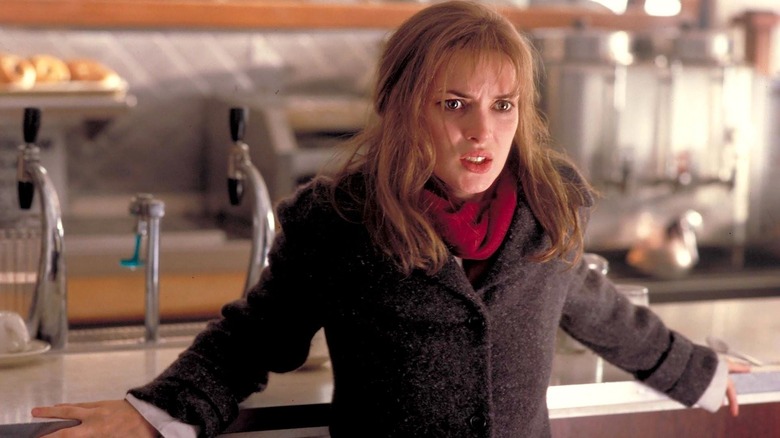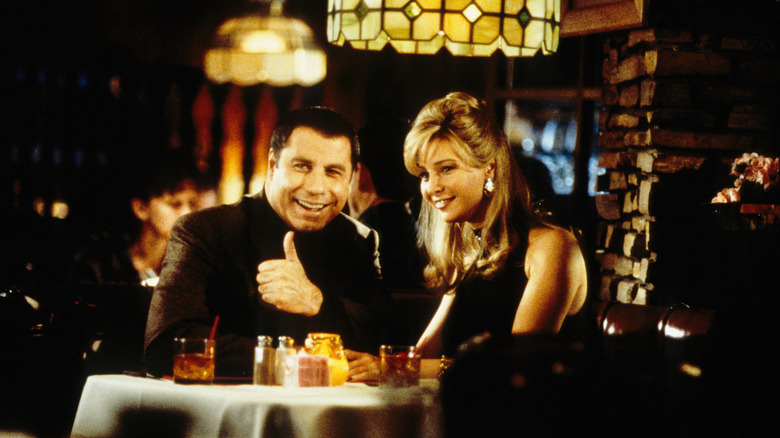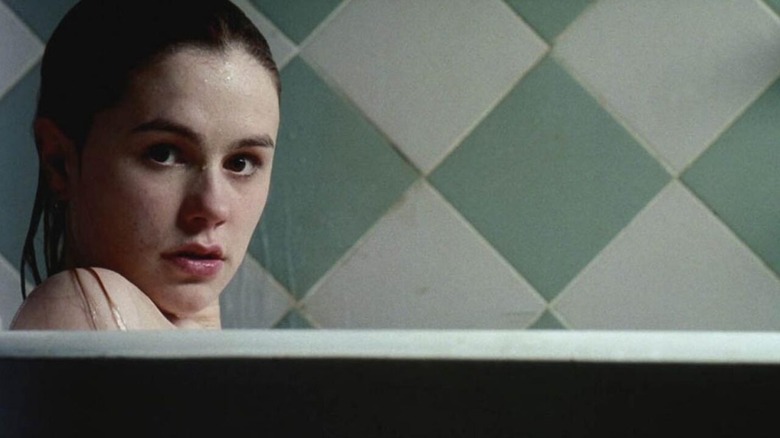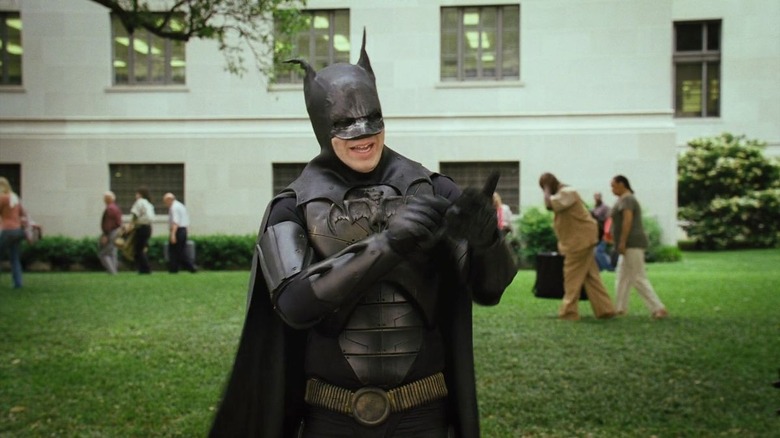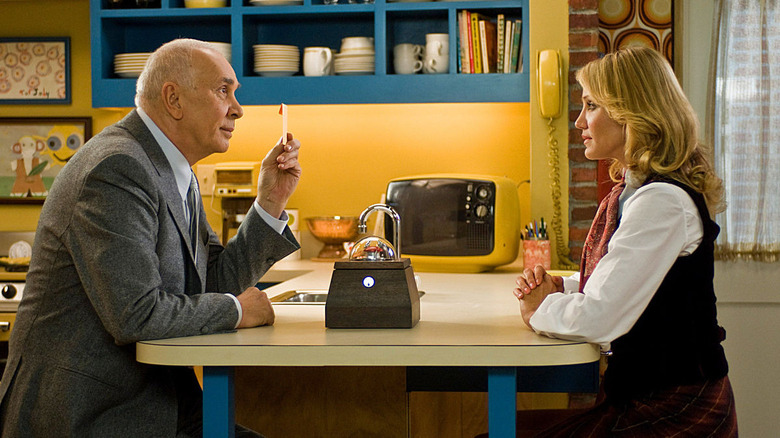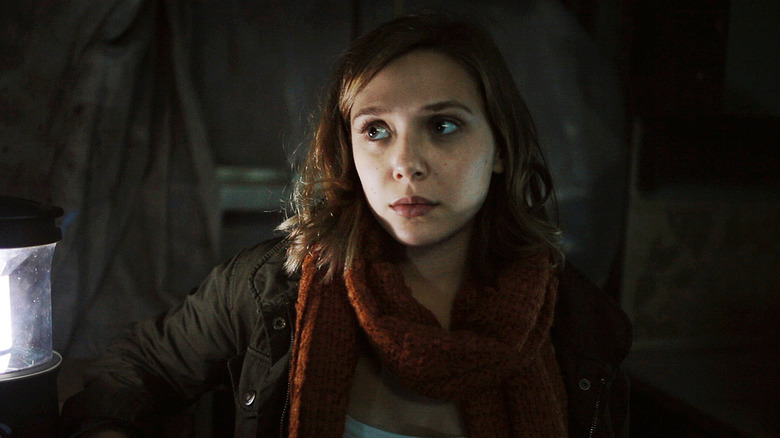Every Single Movie That Scored An F CinemaScore Grade
The name of CinemaScore gets dropped a lot in discussing modern movies and especially their box office performances, but what exactly does that phrase refer to? CinemaScore is a research firm tasked with polling moviegoers on the opening night of wide-release movies to see how much they liked what they just watched. There are countless problems with CinemaScore and its evaluation process, but it's still a very prominent part of the film industry, warts and all. Through the rating audiences initially give a film, one can also find a lot of potential evidence for exploring what genres and themes audiences are gravitating towards or repelled by at a particular moment in time.
There's a lot to unpack from the select few movies that have garnered F CinemaScore grades over the past four decades. It's not common for newly released features to get such severely distressing ratings, but they do happen. The features that secured these F ratings have ranged wildly from disposable horror films lost to time to auteur-driven dramas that were mismarketed as broadly appealing genre fare. Looking through these movies in chronological order, one can appreciate the wide variety of factors that led to these movies becoming so divisive for the general public. CinemaScore is far from perfect, but it helps lend some insight into how moviegoers feel about these specific motion pictures.
Bolero
With the movie "10," Bo Derek exploded onto the radar of moviegoers as both a sex symbol and an actor to watch. She even managed to score a Golden Globe nomination for her work in "10," which was only her second acting credit. There were high expectations for where Derek would go next as a performer, though she never quite got back to that level of exciting momentum. By 1984, she was already headlining box office duds like "Bolero," which was so despised by moviegoers that it scored an F rating from audiences in the nascent years of CinemaScore's existence.
There were countless reasons why "Bolero" was torn to shreds by the general public, though its overlong runtime of 104 minutes could be a key culprit, since that aspect stretched "Bolero's" plotline — which concerns a woman seeking out the perfect person to take her virginity — well past the breaking point. It didn't help that "Bolero" also had an incredibly stiff and strait-laced tone with no room for the kind of inadvertent comedy that makes something like "The Room" such a cult classic. Moviegoers trapped in a theater watching "Bolero" were simply bored by what was on-screen rather than unintentionally amused by it. Unsurprisingly, it was five more years before Bo Derek returned to the silver screen with another star vehicle after this debacle.
Eye of the Beholder
As the 20th century was drawing to a close, the second film ever to score an F CinemaScore grade finally arrived. The project that scored this dubious honor was the 1999 Stephan Elliot thriller "Eye of the Beholder." Headlined by Ewan McGregor and Ashley Judd, the film saw McGregor portraying a spy who follows a serial killer (played by Judd) across the United States. But along the way, he ends up forming an attachment to her. It's a story that employs several uses of inexplicable imagery and narrative turns, all in the hope of creating an atmosphere that would leave audiences unsure of where it was going next.
In the process, "Eye of the Beholder" just created an atmosphere that audiences hated. The creepy behavior on the part of McGregor's protagonist (which Elliot often plays off as sweet or tender) undoubtedly put off viewers, as well as the strange cinematography that leaves "Eye of the Beholder" visually incomprehensible in some spots. Plus, all the ambiguity resulted in a slow feature that failed to deliver the thrills moviegoers were looking for. If an acclaimed noir homage like "Drive" couldn't win audiences over because of its pacing, then there was no chance something as dismal and slow as "Eye of the Beholder" would be a crowd pleaser. No wonder this Ewan McGregor vehicle became only the second 20th-century movie to get the dread F CinemaScore grade.
Dr. T & the Women
In his career, director Robert Altman was responsible for some of the most acclaimed movies of all time. Titles like "Nashville" and "McCabe & Mrs. Miller" have become indisputable classics since they debuted, while even more divisive projects like "Popeye" have major cult followings. A director this ambitious is bound to produce something that resonates with people even when he fails to deliver a new masterpiece. However, one of the more disposable entries in his vast filmography was the 2000 directorial effort "Dr. T & the Women," which paired up Richard Gere with an all-star supporting cast of ladies ranging from Helen Hunt to Farrah Fawcett to Laura Dern, among many others.
None of those performers were able to win over general moviegoers, who branded "Dr. T & the Women" with an F CinemaScore grade. Part of the issue was that this feature was marketed as a star-studded romantic comedy. It was actually a more tonally complicated movie that went down some truly absurd narrative avenues. The sight of Richard Gere driving into a tornado may have satisfied Altman on the set of "Dr. T & the Women," but it resulted in a feature whose final 30 minutes left a sour taste in the mouths of moviegoers. Plus, the peculiar tone of the movie, which struggled to balance lightness with darker concepts, divided critics and alienated the general public. Chalk this one up as a strangely sizeable misfire for a legend like Robert Altman.
Lost Souls
As a cinematographer, Janusz Kaminski has a filmography that's tough to beat. A go-to collaborator with Steven Spielberg starting with "Schindler's List" in 1993, Kaminski has an avalanche of visually striking movies under his belt ranging from "Jerry Maguire" to "The Diving Bell and the Butterfly," among many others. However, this talent didn't quite translate to his debut as a director in 2000 with the horror feature "Lost Souls." This movie went over dreadfully with moviegoers.
Bestowed with an F grade by audiences, Kaminski's work on "Lost Souls" was dreadfully bereft of memorable scares, the kiss of death for any mainstream horror film. Moviegoers will tolerate a lot in the pursuit of frights (like contrived plot points or stilted acting) but a deficit of scares is impossible to overcome. Plus, "Lost Souls" delivers an ending that drops one big twist after another on viewers before concluding in a very abrupt manner. While a soaring ending wouldn't have fixed every problem in "Lost Souls," it certainly would have sent audiences out of the theater (and, in the case of Friday night viewers, into the arms of CinemaScore pollers) on a much more satisfied note. Unsurprisingly, after helming a film that got such toxic buzz, Kaminski has largely stuck to cinematography in the decades since "Lost Souls" premiered.
Lucky Numbers
The dominant genres that have garnered F CinemaScore grades over the years have been dark dramas and horror movies. These films, with their bleak tones and often ambiguous endings, aren't the kind of things that send viewers out of the theater happy or feeling satisfied — often intentionally. By contrast, comedies are scarcer in this field simply because many of these movies do offer concrete resolutions, rarely leaving audiences feeling wrong-footed. An artsy horror film might not give you any of the scares you were promised, but the average Happy Madison comedy will at least deliver attempts at laughs (however misguided they may be). This explains why something as critically savaged as "Bucky Larson: Born to be a Star" still secured a B CinemaScore grade from audiences.
However, not every comedy is impervious to this phenomenon. The 2000 John Travolta and Lisa Kudrow vehicle "Lucky Numbers," per the CinemaScore website, garnered an F rating. This feature was especially reviled by the public because it was a misguided stab at a dark comedy, a genre that can become insufferably mean-spirited if done poorly. The abysmal critical reviews for "Lucky Numbers" make it clear that nothing could salvage this one's public reputation, but the film's CinemaScore grade was also likely exacerbated by John Travolta being an especially ripe punching bag in 2000, thanks to the then-recent failure of "Battlefield Earth." A perfect storm of factors swirled around "Lucky Numbers" to make it the rare comedy to flunk with audiences this badly.
FeardotCom
Horror films can often be dismissed as junk food cinema, but that's giving the genre an incredibly insulting short shrift. Scary movies have the power to be vivid reflections of the anxieties of a specific era. They're just as capable of illuminating the inner psyche of general moviegoers as they are at being low-budget stabs at easy cash. Of course, not every horror feature that attempts to be relevant lives up to its potential. Take the 2002 title "FeardotCom," which aimed to be the "Nightmare on Elm Street" for a generation of moviegoers raised on AOL dial-up. An ideal execution of this premise could deliver a horror film that spoke profoundly to those living in the internet age.
Unfortunately, "FeardotCom" missed the mark on that front, as evidenced by its F CinemaScore grade. One weird element about "FeardotCom" in hindsight is how much of its horror hinges on vicious torture sequences, two years before "Saw" made that style of scares much more mainstream. "FeardotCom" was too ahead of the curve in this regard and the emphasis on such brutality just wasn't what audiences were hungry for yet. Plus, its final 30 minutes are packed with contrived twists that turn the whole film into a ludicrous farce — albeit an unfunny one. Horror films have a lot of power to speak insightfully about the larger world. Just don't look at "FeardotCom" for proof of this phenomenon.
Solaris
The 2002 feature "Solaris" was helmed by Steven Soderbergh and functioned as a new adaptation of the Stanislaw Lem novel of the same name, which was previously turned into a motion picture by filmmaker Andrei Tarkovsky. "Solaris" has a certain pedigree that was only enhanced by the presence of George Clooney in the lead role. With such prominent names all connected to the feature, one would expect "Solaris" to be a divisive movie, but also one that might find pockets of enthusiasts among mainstream moviegoers. Instead, "Solaris" was despised by viewers and given an F CinemaScore grade, an unthinkable result for a feature headlined by an actor as widely associated with crowd-pleasing ventures as Clooney.
Shortly after the release of "Solaris," Clooney opened up to the Seattle Times to divulge his frustrations over how "Solaris" was marketed. Specifically, he found that every ad or trailer for this sci-fi title felt totally disconnected from the final product. Clooney's grievances pinpoint a key reason why "Solaris" went over so poorly with audiences. Misleading marketing campaigns often inspire anger from moviegoers, as people prefer to get exactly what they were promised on a poster when they sit down to watch a movie. Plus, the extremely glacial pacing of the project was always bound to be divisive, even if the marketing campaign had been perfect. No amount of buzzy behind-the-scenes talent or artistic pedigree could salvage the reputation of "Solaris" among audiences.
Darkness
Unfortunately, the title of "Darkness" does not refer to its humorous use in a song sung by Lego Batman in "The Lego Movie." Instead, "Darkness" is a 2004 horror film by director Jaume Balagueró that originated in Spain. The feature had spent years in limbo when it came to getting released outside of its home country thanks to North American distributor Miramax engaging in severe editing to make it more "marketable." A tragically common practice for many foreign titles acquired by Miramax, "Darkness" ended up losing around 14 minutes of footage when all the trimming was done.
This behind-the-scenes turmoil is important to consider when grappling with just how reviled "Darkness" turned out to be by general audiences. Inevitably, the cut released to North American moviegoers was so jarringly edited and incoherent that it got audiences irritated, not terrified. It's also yet another horror movie that concludes on an open-ended note that suggests terrible things will eventually happen to our lead characters, but doesn't offer a concrete resolution. After sitting through so much impenetrable storytelling, audiences wanted something more satisfyingly definitive. This makes it unsurprising that "Darkness" was given an F grade by audiences, though it does provide an ironic finish to a feature whose post-production was plagued by studio interference to make it "more audience friendly."
In the Cut
"In the Cut" is not a movie that was ever going to really click with mainstream audiences. It's just too offbeat and strange, a project that sees writer and director Jane Campion reconfiguring noir tropes to provide commentary on the harmful effects of the male gaze. It's a weighty project punctuated by unorthodox filmmaking touches (like the shifting color tone when the story goes for a flashback sequence) that reflect just how jaggedly disjointed it can often be to exist as a woman on a day-to-day basis. In other words, "In the Cut" is a movie meant to stir up conversation and debate over its underlying intent rather than being an instant favorite among all audience members.
Audiences weren't as charitable in their interpretation of "In the Cut" and gave the movie an F CinemaScore grade. Part of this lies with the innately audacious qualities of the movie, but that F grade also reflects how "In the Cut" was initially misunderstood by critics and moviegoers alike. Over the years, its reputation has improved significantly and there's a greater understanding of the lofty ideas this story was reaching for. However, it took time for this more nuanced perception of the production to emerge. Initially, "In the Cut" was dismissed far and wide as a major misfire by Jane Campion, as reflected by that cutting F CinemaScore grade.
Alone in the Dark
If one is talking about the most reviled movies of the 21st century, it's only a matter of time before director Uwe Boll enters the conversation. A staple of 2000s genre cinema, Boll's films were infamous for inexplicable casting choices (like Burt Reynolds showing up in the period-piece fantasy film "In the Name of the King: A Dungeon Siege Tale") and atrocious dialogue that inspires unintentional fits of giggles from viewers. Among his early notorious works was "Alone in the Dark," a video game adaptation that dropped into theaters in January 2005.
This motion picture proved so dreadful that audiences gave it an F CinemaScore grade. For some artsier movies, it's a very nuanced process breaking down the reasons a feature was so rejected by general moviegoers. In the case of "Alone in the Dark," the explanation is fairly simple — it's just not very good. It begins with a lengthy opening text crawl that's read aloud to the viewer. This unintentionally hilarious choice is followed up by a barrage of confounding editing and screenwriting that ranks up there with "Oh hi, Mark," in terms of baffling ineptitude. When people bought a ticket to "Alone in the Dark," they just wanted to watch some sci-fi horror carnage for a few hours. Considering they instead got an unintentional comedy that makes "Plan 9 from Outer Space" look like "Alien," it's no surprise moviegoers found "Alone in the Dark" worthy of the F CinemaScore grade.
Wolf Creek
To say that "Wolf Creek" is a harrowing movie is a bit of an understatement. It never lets up with its unflinching depictions of unspeakable violence, nearly all of it targeted against women. This approach divided critics, who were torn between thinking the craftsmanship on display justified the onslaught of misery and feeling as though it was all just torment with no underlying point. Audiences were significantly more unanimous in their opinion on "Wolf Creek." Giving the movie an F CinemaScore grade, it was apparent that "Wolf Creek" just didn't work for the general public.
Though some filmmakers may have been discouraged to see audiences so thoroughly reject their work, "Wolf Creek" director Greg McLean held the movie's F CinemaScore grade up as a badge of honor. McLean explained to ComicBook.com in 2017 that the primary factor behind "Wolf Creek" getting an F rating was that it was so different from traditional horror fare. To see moviegoers so viscerally respond to what was happening on-screen that they could only respond with an F CinemaScore rating made McLean quite proud. Plus, McLean considers CinemaScore grades more of a reflection of whether or not moviegoers got their pre-viewing expectations met rather than a microcosm of a motion picture's actual quality and merit. These perspectives meant he had no problem with a film as draining as "Wolf Creek" going over poorly with audiences.
The Wicker Man
Since its release, the 2006 Nicolas Cage horror film "The Wicker Man" has inspired plenty of joy, thanks to rampant internet memes based on its most ludicrous moments. Conceptually horrifying scenes of Cage being tortured by hordes of bees were turned into hysterical online material all centered around Cage's unique line deliveries of dialogue like "Not the bees!" In these small, out-of-context bursts of absurdist internet material, "The Wicker Man" is a comedic triumph. As a feature-length piece of horror cinema, though, "The Wicker Man" didn't please anybody.
On its opening weekend, moviegoers dubbed "The Wicker Man" worthy of an F CinemaScore grade. It wasn't just a handful of unintentionally hilarious moments, like Cage running up to punch somebody while in a bear outfit, that guaranteed "Wicker Man" such a disastrous audience rating. This horror film also ended on a dark note, suggesting that every horrific thing that befell Cage's protagonist would inevitably happen again and again, with no end in sight. Without any concrete resolution, audiences felt cheated by what they'd just witnessed. It didn't help that the original "Wicker Man" movie is a masterpiece of folk horror, and the reputation of that earlier feature undoubtedly further highlighted the already apparent flaws in this remake. However, "The Wicker Man" can at least take mild comfort in knowing it inspired a swarm of well-liked memes, an accomplishment many other movies with F CinemaScore grades never came close to achieving.
Bug
The final moments of the 2007 William Friedkin movie "Bug" leave viewers intentionally puzzled over what was "real" in the preceding film and what was fiction. The feature concerns two people gripped by paranoia that escalates into violent delusions, with neither one truly tethered to reality. There are no easy answers as to what is real and what isn't, just constant uncertainty transporting viewers into these paranoid mindsets. This is a movie meant to challenge moviegoers rather than hand them easy answers on a plate. Naturally, this didn't go over well with the general public, especially with pre-viewing expectations that "Bug" would be a normal horror film that offered easily digestible scares.
Upon its release to theaters in May 2007, "Bug" was given an F CinemaScore grade. That shouldn't be a surprise to anyone, given the unorthodox material and ambiguous reality presented. Even critics accustomed to such artsy forays into works that bend genre norms gave "Bug" mixed marks. No wonder average moviegoers were bewildered rather than compelled by what they were watching. Plus, "Bug" opened in May 2007, directly against more traditional summertime fare like "Pirates of the Caribbean: At World's End." The hottest months of the year are usually home to movies that deliver plenty of surface-level spectacle, and "Bug" stuck out like a sore thumb in this release window. All of these factors make it clear why audiences wanted to flick away "Bug" like a pesky insect.
I Know Who Killed Me
Movies never remain just movies. Once they're put out into the world, they inevitably take on larger significance beyond what the artists behind these works could've ever imagined. So it was with the 2007 erotic thriller "I Know Who Killed Me," a project directed by Chris Sivertson and starring Lindsay Lohan. This dark feature saw Lohan playing a woman struggling with her identity in the wake of being abducted and tortured. On paper, it wasn't a bad idea for a film that could solidify Lohan's gifts as an actor distinct from her child star career. In execution, though, things went haywire. Before "I Know Who Killed Me" even came out, it was already at the center of tabloid reports obsessed with every move Lohan was making.
With Lohan's mid-production rehab stint dominating the pre-release headlines, "I Know Who Killed Me" needed to be a masterpiece to evade all the toxic buzz. Unfortunately for everyone involved in this movie, it was far from that. Initial critical reviews were disastrous and audiences bestowed "I Know Who Killed Me" with an F CinemaScore grade. It's impossible to tell if all the Lohan-centric publicity hurt the film's audience reception, but it couldn't have helped. If there's one silver lining, though, it's that "I Know Who Killed Me," unlike many other F CinemaScore movies, has garnered a notable cult following in recent years.
Disaster Movie
In hindsight, it's baffling that something like "Disaster Movie" was put into theaters, let alone given a massive wide release. While other parody movies from directors Aaron Seltzer and Jason Friedberg at least started with the idea of spoofing a specific movie or genre, "Disaster Movie" was just skewering a slew of summer 2008 titles that hadn't even come out yet when this project was filming. It was a barrage of acknowledgments of other pop culture properties instead of any actual comedy, a nadir for parodic filmmaking and cinema as a whole. While audiences had shown up in notable numbers for earlier Seltzer and Friedberg titles like "Date Movie," viewers weren't anywhere near as kind to "Disaster Movie."
This feature landed a dreaded F CinemaScore grade, a demonstration that critics and audiences were in lockstep on the quality of this comedic disaster. Previous Seltzer and Friedberg films weren't beloved by audiences, but even "Meet the Spartans" (which dropped just seven months before "Disaster Movie") was able to get a C- CinemaScore grade. "Disaster Movie" fared even worse for a multitude of reasons, including the use of incredibly creepy costumes for dark versions of characters like Po the Panda and its style of raunchy humor trying awkwardly to fit into a PG-13 rating. There's really no end to the factors that led to audiences wholly dismissing "Disaster Movie."
The Box
In the 2009 Richard Kelly movie "The Box," a married couple (played by Cameron Diaz and James Marsden) are faced with an enormous choice. They can press a button inside a box and get tons of money — but somebody in the world that they don't know will die. It's a moral quandary that sends the lead characters down a rabbit hole of conspiracies so labyrinthine that it's no surprise the film hails from the same mind behind "Donnie Darko." However, while Diaz and Marsden's characters struggled to figure out whether or not to tamper with that fateful box, audiences had absolutely no problem assigning a stinging F grade to "The Box."
"The Box" falls neatly into the camp of many motion pictures that received F CinemaScore grades: It's a genre exercise that offers lots of inexplicable events to the viewer but no explanations for what's going on. By the end of "The Box," this fictional universe has expanded to include the very fabric of space and time itself, not to mention some infamous water tombs. It's all just the sort of intentionally baffling material that one would expect from Richard Kelly, but it's also guaranteed to leave audiences frustrated rather than satisfied.
The Devil Inside
One of the most infamous movie endings of all time can be found in the final seconds of "The Devil Inside," which abruptly cuts away from the immediate aftermath of the main characters being in a car accident to a wall of text informing moviegoers that, if they want more information on this "real case," they should go to a website link. Any potential dramatic resolution to the story audiences have been invested in for the last 80 minutes is thrown out of the window. It's an incredibly underwhelming conclusion and a downright insult to anyone hoping for a satisfying standalone story within "The Devil Inside."
Needless to say, such an abrupt wrap-up did not go over well with moviegoers. While other aspects of "The Devil Inside" inspired criticism, this conclusion proved especially divisive, and it being the last thing audiences saw before exiting the theater undoubtedly impacted this movie's CinemaScore grade. "The Devil Inside" scored an F grade from moviegoers, a dire rating even by the standards of horror movie audience responses. The film's dreadful word-of-mouth helped ensure its rapid descent from the top of the box office. Needless to say, this open-ended approach to concluding a mainstream horror movie has not been replicated in the years since "The Devil Inside" frustrated horror fans across the globe.
Silent House
Before she took on the role of Wanda Maximoff in the Marvel Cinematic Universe, one of Elizabeth Olsen's very first leading roles came in the microbudget horror movie "Silent House." To make sure this feature stood out from the crowded pack of scary films out there, "Silent House" had the special flourish of occurring in "real-time." Its story was captured in a simulated single take, a gimmick it embraced long before "Birdman" and "1917" strolled into town and became Oscar darlings. Such technical details weren't enough to win over audiences, though, who loudly proclaimed "Silent House" was worthy of an F CinemaScore grade.
The interesting wrinkle here is that "Silent House" was not universally trashed by critics like most other mainstream horror titles that get F CinemaScore grades. It received mixed reviews, but was far from having no defenders. Unfortunately, while its ambitious technical aspects (especially in terms of camerawork) were enough to save "Silent House" from total critical dismissal, its bleak tone and a barrage of strange narrative turns in the second half of its script undoubtedly alienated moviegoers. Plus, the faux-single-take filming gimmick likely puzzled many moviegoers. Horror films often receive the worst CinemaScore grades possible, but something like "Silent House" proved especially alienating to the general public.
Killing Them Softly
"Killing Them Softly" is a prime example of a movie that should've leaned into a theatrical run emphasizing arthouse theaters and audiences. With those moviegoers, "Killing Them Softly" could've had a chance to build up a better reputation. Director Andrew Dominik's bleak crime drama, which also functions as an equally morose reflection on the optimism of the Obama era, is not an easy film to watch, nor is it meant to leave you feeling enthralled. It's a grimy motion picture that offers up a mirror to our country and audiences themselves, right down to its unforgettable final line of dialogue.
Naturally, then, The Weinstein Company decided that because "Killing Them Softly" was anchored by movie star Brad Pitt, it should be dropped into over 2,400 theaters right away in the middle of the holiday season. Inevitably, a film with this release strategy marketed as just a general crime drama was despised by audiences — they wanted something traditional, not subversive and angry. "Killing Them Softly" so missed the mark in fulfilling audience expectations that it received an F grade from moviegoers and almost immediately vanished from movie theaters after its opening weekend. It's doubtful a feature as grim as "Killing Them Softly" would've taken off under any circumstances. But the release strategy hardly did it any favors.
mother!
After 2012, the F CinemaScore grade remained silent for five years. No new wide release received such vicious responses from the general public and studios didn't have to deal with an abnormal audience score tanking a movie's reputation online. In September 2017, though, that hiatus came to a very vivid close with the premiere of "mother!" This was the newest release from filmmaker Darren Aronofsky, whose preceding two directorial efforts ("Black Swan" and "Noah") each cracked the $100 million mark domestically. Such a financial fate was not in the cards for "mother!," especially after it received an infamous F mark from audiences on its opening weekend.
It's interesting that "mother!" was the next movie to get the F CinemaScore grade after "Killing Them Softly," since both titles are a bit similar. Each is headlined by a big movie star (in the case of "mother!," the iconic lead was Jennifer Lawrence) and each was marketed as a bold new entry in a very accessible genre. However, "mother!" was not a standard horror film — it's a relentlessly dark movie, drenched in symbolism that culminates in a baby getting ripped apart on-screen and Lawrence getting physically abused. Both of these titles were way darker and more grueling to watch than audiences expected and neither one offered a concrete ending after viewers had been through so much. These qualities inspired audiences to slap "mother!" with the first F CinemaScore grade in years.
The Grudge
After a career of turning in sterling performances in a variety of movies across wildly differing genres, Andrea Riseborough scored her first Oscar nomination at the 95th Academy Awards ceremony for her lead role in "To Leslie." This remarkable performance is far from the first Riseborough turn that could've been up for the Oscars, since she's amassed a truly impressive collection of work. However, in a career as long as hers, it's inevitable that she would end up in one or two creative misfires. One of her most notable artistic missteps came just two years before the premiere of "To Leslie" with the horror remake "The Grudge," which Riseborough herself headlined.
She wasn't the only notable name in the cast of this new take on the "Grudge" universe, as the likes of Demian Bichir, John Cho, Jacki Weaver, and more were all scattered throughout the film's inexplicably stacked supporting cast. None of these impressive performers was enough to win over any favor from audiences, who gave "The Grudge" an F CinemaScore grade. Several elements of the feature (like its clumsily organized, non-linear narrative structure) likely put audiences in the mood to despise "The Grudge" long before the credits began to roll. However, a comically-abrupt ending that tosses in one more scare from out of nowhere and implies the death of Riseborough's protagonist was enough to inspire audience frustration and secure "The Grudge's" place in the pantheon of F CinemaScore movies.
The Turning
Perhaps we all should have recognized that 2020 would be a dark year for movies, once January 2020 delivered two separate features that garnered F CinemaScore grades. Exempting the trio of features that scored that grade in 2012, this marked the first year since 2007 when multiple movies were deemed worthy to be given an F grade. The second feature to score this dubious honor in 2020 was yet another horror film. Directed by Floria Sigismondi, "The Turning" was anchored by Mackenzie Davis as a woman who must watch over a pair of kids (Finn Wolfhard and Brooklynn Prince). These youngsters turn out to be quite troubled souls, and the ancient house they inhabit is equally disturbing.
"The Turning" eventually pulls out a bunch of strange "twists" in its final moments, including a reveal that a big chase scene set piece was all just a vision, in an attempt to keep audience members on their toes. Instead, this screenwriting decision clearly just irritated moviegoers and left them unsatisfied. Plus, the decision to go with a PG-13 rating on this horror film ensured it couldn't even deliver lots of gory deaths or memorable kills to give viewers an extra jolt of adrenaline. "The Turning" failed miserably and it, combined with "The Grudge," proved an unfortunate harbinger of all the problems that awaited cinematic storytelling in 2020.




